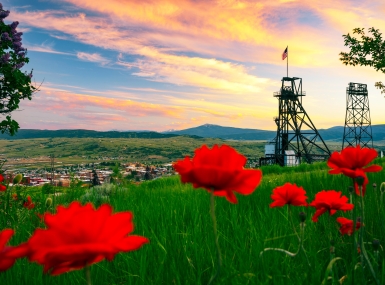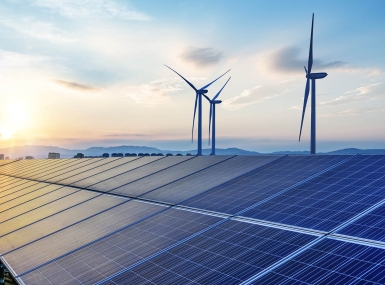Energizing Counties

America’s counties are home to a wide variety of natural primary sources of energy. A diverse portfolio of electrical energy production is essential to America’s leadership in every field from health care to advanced manufacturing to artificial intelligence. Technological advances in solar, wind and nuclear energy have unleashed energy potential that was previously limited to counties with large coal or natural gas reserves. Now, more counties than ever are at the front lines of energy development and are playing a critical role in the energy future for our communities. County governments regulate energy development through permitting, land use planning, community engagement and more.
NACo empowers counties with the tools and resources needed to consider and facilitate energy projects best suited for local communities. NACo is developing resources and tailored guidance to assist local governments in navigating the opportunities and challenges of different energy industries.
Energy Technologies
Electrical Energy systems are classified in different ways based on the fuel source and type of by-products generated.
Conventional energy systems are powered by non-renewable fuels that will eventually deplete or will take millennia to regenerate naturally, like coal, natural gas, oil or nuclear power. Since the fuel here can be harvested and stored, the energy can be generated on demand. While the flexibility and reliability of fuel-based energy has many benefits, its generation also has some drawbacks, including danger to miners and workers and the release of particles and gases. Due to the logistics needed at every step from fuel extraction to transportation and usage, these systems are only used at large scale and are owned and operated by large industries.
Non-conventional energy systems are powered by renewable sources, like water (hydro), wind, solar, geothermal and tidal, that do not deplete. Because they produce negligible harmful by-products relative to conventional systems, they are often referred to as “clean energy” systems. Some of these sources can be intermittent and less reliable to our current grid system than conventional systems. However, the ease or absence of fuel management allows consumers and communities the flexibility to generate clean energy in their own backyard or rooftop and the ability to turn off and turn on the system as needed.
There are also other fuel sources that do not neatly fall into either of the categories above. For example, nuclear energy utilizes depletable fuel sources like Uranium but has minimal harmful emissions in the power generation process. However, the potency of nuclear fuels demands a very high level of caution in the handling of the fuel, operation of the generators and the disposal of the spent fuel. Bio-energy systems, such as wood-burning and waste-to-power generation, also fall into a different category since the fuel regenerates naturally in a reasonable amount of time. But burning this fuel creates harmful by-products that require management.
Regardless of source, energy generation is most efficient at the source of fuel and depends on a robust transmission and distribution network to transport the power to end users. With energy storage industry advances comes greater flexibility for when and how the energy is used regardless of how it was generated.
County Energy Explorer
View the interactive map of wind energy projects in full screen. Click here to access the maps for other energy technology types on NACo's County Explorer, including coal production, plants and mines; solar energy production and plants; and battery storage power plants.
Rural Energy Academy
Rural Energy Academy
NACo's Rural Energy Academy is a unique opportunity for rural county leaders to engage with subject matter experts and peers exploring their energy production potential. This initiative follows the work of NACo’s Building Resilient Economies in Coal Communities (BRECC), which focused on supporting coal community leaders as they diversify local economies and plan for a more resilient future for their residents and workers. One key finding of the BRECC network was that their grid-connected infrastructure and geographies can often make exploring new energy technologies a viable economic development strategy.
In this first phase, NACo’s Rural Energy Academy will focus on helping rural county leaders navigate development and siting of potential wind and solar energy projects and whether they are right for their communities. Recent incentives, changes in federal policy and increased attention on rural areas with wind or solar resources has created a meet-the-moment opportunity for rural counties. In response to member requests, the Rural Energy Academy will offer site visits, technical assistance and peer learning opportunities to support rural leaders as they make local decisions that will work best for their communities.
Energy Counties Exchange
NACo's Energy Counties Exchange is an information sharing platform for county leaders to discuss local challenges and solutions at work in America’s energy counties. Join today to connect with a community of peers, share local ordinances and insights on energy production and receive updates on NACo research, resources and activities focused on energy generation at the local level.
Program Contacts

Blake Gardiner

Padma Kasthurirangan
Related News

U.S. Department of Agriculture unveils $700 million for regenerative agriculture
On December 10, U.S. Secretary of Agriculture Brooke Rollins announced the launch of a $700 million pilot program to support regenerative agriculture practices across the country.

County Countdown – Dec. 1, 2025
Every other week, NACo's County Countdown reviews top federal policy advocacy items with an eye towards counties and the intergovernmental partnership.

Counties Celebrate Key Permitting Inclusions in SPEED Act
NACo issued the following statement in response to the passage of the Standardizing Permitting and Expediting Economic Development (SPEED) Act (H.R. 4776), which advanced out of the U.S. House Committee on Natural Resources on November 20.


